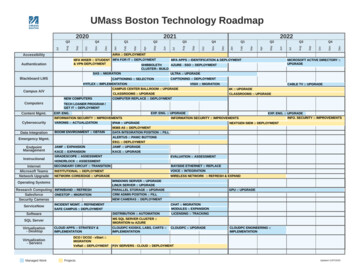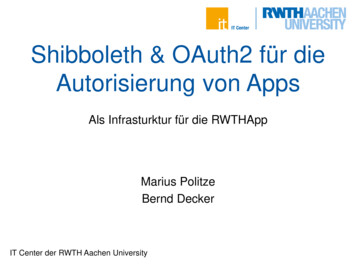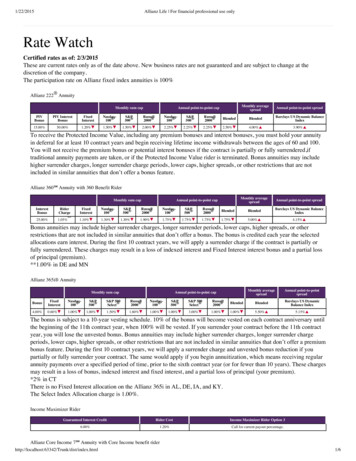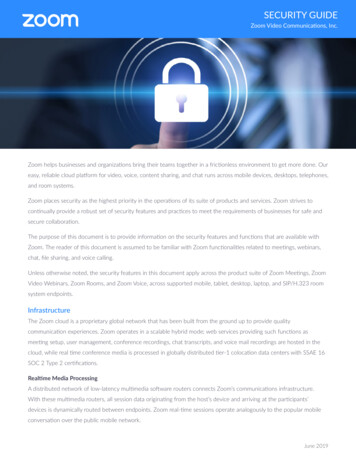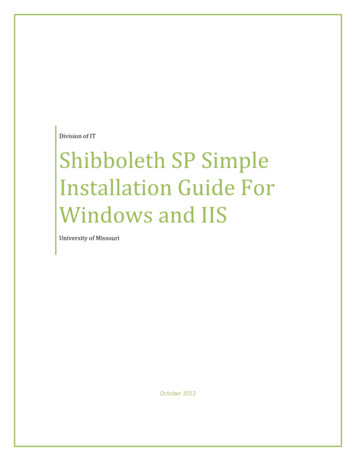
Transcription
Division of ITShibboleth SP SimpleInstallation Guide ForWindows and IISUniversity of MissouriOctober 2012
1. Background1.1.What is a Service Provider?To put it simply, a service provider is the website you are trying to secure. Users authenticate to yoursite and you provide a service to them or send them away if they are not authorized to use your site.For Windows installations, the service provider has a windows service and an ISAPI module that loadsinto IIS. Like Linux, on Windows these two components work together with the Shibboleth IdP toauthenticate users and provide information to your IIS application.1.2.How does my application integrate with the Shibboleth SP software?The Shibboleth SP service and IIS ISAPI modules provide your application with one or more environmentvariables that you may use in your code to determine which users are visiting your site. If you've writtenyour application to use REMOTE USER or a similar variable then you can probably use Shibboleth. Thereare issues when using REMOTE USER in IIS, so the Shibboleth authors recommend picking a differentvariable name for a username, that name can be configured during the SP software setup.Commercial applications that can use an environment variable for a username can often also beconfigured to use Shibboleth. At the University of Missouri, Shibboleth has been used to securecommercial applications like Coldfusion, Oracle Apex, Blackboard, and PeopleSoft's portal. The key tomaking this work is that the application must turn off its default authentication system and rely onauthentication services configured in IIS.1.3.Can Shibboleth tell me if a visitor is enrolled in a specific course orwhether they are enrolled as a full or part-time student?Shibboleth is best used as an "authentication" service. That is to say it tells your application who aperson is (his or her username) and to a limited extent what roles within the institution the person mayhave, e.g. "staff", "student", etc. Shibboleth performs all lookups for all users that login. Havingapplication specific authorization criteria will make the login process slower and less reliable for allapplications. If your application needs more explicit information about a visitor, it is best if theapplication takes the username information and queries other data sources to determine whether thatuser is authorized to access a particular resource.1.4.What if my application doesn't run under IIS?Most windows web applications use IIS as the engine that handles requests from users' browsers.Shibboleth doesn't run on anything but Apache or IIS. It may be possible to run an SP on Windowsservers using Apache, but this document focuses on IIS integration. For Apache integration, pleaseconsult the Linux install guide and the Shibboelth documentation site. That said, it is also possible to useIIS to protect web applications that run in a Tomcat, WebSphere, JBoss or other application environmentwith Shibboleth. You simply have to use an ISAPI module to connect IIS to Tomcat or other applicationserver. This will put IIS/Apache "out in front" of your application server to handle security, then theIIS/Apache will pass user credentials through to your application. See Appendix A for further discussion
Shibboleth SP Simple Installation Guide For 2012Windows and IISof using IIS/Shibboleth as a "reverse proxy." This method of securing applications is very common, butrequires a thorough understanding of the underlying application.2. Installing a Simple Service ProviderThis section describes the process of installing a simple IIS 7 backed Service Provider (SP) thatcommunicates with the University of Missouri System Shibboleth Identity Provider (IdP) from theinitial request to succesful integration in the production environment.For a comprehensive installation guide please see the Native SP Windows install pages on theShibboleth Wiki. B2/NativeSPWindowsInstallPrerequisites for Installation: A basic understanding of web applications in general as well as your application and in particularhow your application authenticates users.For Windws SPs: A remote desktop client, the ability to navigate directories and use a text editorfor windows.A way to install the SP software on your host either with root/administrator access or by havingsomeone who can install the software for you.Permissions to modify the shibboleth configuration files, your Apache configuration files or IISconfiguration AND the ability to start and stop the shibboleth service as well as IIS.You must have already configured your website with an SSL certificate and at the very least setup a sample application or directory that you can use to test that Shibboleth is working. SSLcertificates that are recognized by nearly every browser are available free of charge forUniversity domains from your campus IT organization or the Division of IT SSL certificates es/2.1.Service Provider Request ProcessAny University application owner who wishes to integrate with the University of Missouri ShibbolethIdentity Provider should complete the request form which can be found on the IT Security Shibbolethpage (http://doit.missouri.edu/security/shibboleth/). The completed form will be automaticallysubmitted to the UM DoIT Shib Support distribution list for processing.2.2.Prepare Windows by Installing IIS and other Pre-requisite ApplicationsChose your OS/IIS/Shibboleth architecture. Your entire IIS, Shibboleth and application (.Net etc)software environment must be the same hardware architecture (32-bit or 64-bit). You cannot mixarchitectures on Windows. Even though 32-bit applications will usually run on a 64-bit OS, this is NOTthe case with Shibboleth. It will fail if you run in a mixed architecture environment; often withoutanything to indicate why. Before downloading Shibboleth, verify the architecture you are using for your3Shibboleth Attributes
Shibboleth SP Simple Installation Guide For 2012Windows and IISapplication. If you are using 32-bit, it is best to install a 32-bit version of windows just to avoid anypotential mixing of software architecture components.Note: If you are adding Shibboelth SP support to a server that already has several IIS applicationsinstalled and running, the Shibboleth installer may have trouble configuring the main IIS applcationcontainer and you may be required to configure Shibboleth for each of your application sitesindividually. It is best (but not required) to install Shibboleth in a clean IIS environment.2.2.1. Set Your Machine's HOSTNAME in the hosts FileSetting the server's hostname in the c:\windows\system32\drivers\etc\hosts file will make the installand configuration changes go smoother.1. Open a command prompt window as administrator by typing "cmd" in the search box and inthe resulting list, right-click cmd and choose "Run as administrator".2. Change directories to c:\windows\system32\drivers\etc and run the following command inthe command prompt window to find your machine's IP address "ipconfig /all more". Lookfor your machine's IP address (highlighted in the picture) and remember it.4Shibboleth Attributes
Shibboleth SP Simple Installation Guide For 2012Windows and IIS3. Open the hosts file with notepad.4. In notepad leave the entries for 127.0.0.1 and ::1 and add a new line with your machine's IPaddress and its fully qualified hostname (hostname.domain.edu) followed by a space andthen just the host name.5. Save your hosts file and close notepad and the command window. If you recieve apermissions error on the file, then you most likely did not open the command window with"Run as administrator" permissions.Warning: Do NOT use the underscore character in your machine name. The underscore is NOT a validcharacter in standard DNS host or domain names. Several shibboleth and IIS components use thecomputer's name to communicate with each other. A machine name with an underscore may break thiscommunication.2.2.2. Verify IIS 6 Roles and ISAPI Filters are InstalledThe Shibboleth SP software was written for IIS 6, but is compatible with IIS 7 which is the default installon Windows 2008 R2. To simplify installation and configuration you must install the "IIS 6 ManagementCompatibility" on your Windows server before installing Shibboleth.1. Click Start, click Administrative Tools, click Server Manager2. In the left pane, expand the Roles tree and right-click Web Server (IIS), then seelct "Add RoleServices".3. In the Role Services window scroll to the bottom and verify that IIS 6 ManagementCompatibility" and all of its sub-components are installed. If they are not installed, check theboxes and install them.5Shibboleth Attributes
Shibboleth SP Simple Installation Guide For 2012Windows and IISVerify that support for ISAPI filters and extensions are installed with IIS.1. Click Start, click Administrative Tools, click Server Manager2. In the left pane, expand the Roles tree and right-click Web Server (IIS), then seelct "Add RoleServices".3. Scroll to the "Application Development" section of the Role Services pane.4. Verify that "ISAPI Extensions" and "ISAPI Filters" are installed or install them if necessary.6Shibboleth Attributes
Shibboleth SP Simple Installation Guide For 2012Windows and IIS2.3.Download Shibboleth SP Software for your OSShibboleth software is available in pre-built installers for Windows. We do not recommend trying tobuild Shibboleth from source code on Windows.You must install the version appropriate to youroperating system and choose the correct architecture (32-bit or 64-bit). Use at least SP version 2.4.3 orhigher. Earlier versions have a serious security hole in one of the accompanying software libraries.Shibboleth Service Provider (SP) software can be found at the link 2.4.Install Shibboleth SP SoftwareNote: Installing the SP software requires a reboot of the OS.1. For windows users, download and run the appropriate MSI file for your architecture.2. Run the Installer. It is not signed so you will see a security warning.3. Proceed through the shibboleth installation. Accept the license agreement.7Shibboleth Attributes
Shibboleth SP Simple Installation Guide For 2012Windows and IIS4. Install the SP software into the default location of C:\opt\shibboleth-sp\. Attempting toinstall anywhere else may require changes to the configuration files.5. Let Shibboelth install its service on the default port 1600. The IIS ISAP module and theShibboleth SP service will communicate with each other on this network port. Use Windows'firewall features to block access to this port from other computers. The port is not normallyexposed to the network if windows firewall is active; verify that this is the case.8Shibboleth Attributes
Shibboleth SP Simple Installation Guide For 2012Windows and IIS6. Allow the installer to register the default ".sso" file extension handler in IIS.7. The Installer will show a progress bar while it copies files and sets up the services andenvironment. Click "Finish" and be prepared to reboot your server when prompted.The installation software will automatically create several default configuration files inc:\opt\shibboleth-sp\ and generate a private key and certificate that is used to encrypt/signdata sent to and received from the Shibboleth IdP. We strongly encourage you to use thedefault key and certificate created by the installer. This certificate is not used by IIS, andyou do not need to use the same key/cert for Shibboleth as you are using to protect yourweb site. Using the same key and certificate for your web site and the Shibboelth service willNOT improve your site security and will only make administering your shibbolethconfiguration more difficult. The default "self signed" Shibboleth certificate will expire in 10years.2.5.Configure Service Provider MetadataMetadata is the data used to configure and describe your Shibboleth SP, and there are seemingly aninfinite number of configuration options. However, for most installations only two or three files need tobe changed to get Shibboleth up and running.9Shibboleth Attributes
Shibboleth SP Simple Installation Guide For 2012Windows and IIS2.5.1. Verify that Shibboleth SP Software is Installed CorrectlyAfter your server has rebooted, it is important to verify that Shibboleth installed correctly and startsautomatically. Even though the SP software is not yet configured, it is still capable of producing a statusreport. Viewing the report means that the SP service is running and that the ISAPI filter was correctlyinstalled in IIS.1. Open an InternetExplorer window and open the following URL:http://127.0.0.1/Shibboleth.sso/Status. You should see a bunch of XML returned.2. If you do not see XML then it is possible IIS isn't running or that access restrictions are in place toprevent the status message from appearing. Open a command window as administrator, andrestart IIS by running the iisreset command.3. Change to the shibboleth install directory: \opt\shibboleth-sp\etc\shibboleth and edit theshibboleth2.xml file with notepad.4. Inside notepad scroll to the lower half of the shibboleth2.xml file and edit the section that startswith ' Handler type "Status"'. Modify the acl attribute to include "::1" which is the IP version6 "loopback" address. Also add any other IP addresses you wish to have access to the statuspage. Warning: it is NOT possible to add entire networks or subnets; only individual IP addresseswill work. Addresses are separated by spaces.10Shibboleth Attributes
Shibboleth SP Simple Installation Guide For 2012Windows and IIS5. Restart the Shibboleth SP service by opening the services MMC snap-in, finding the ShibbolethSP service in the list and stoping and restarting it.6. Check the status page again.7. If you still do not see a status page, then most likely the installation is corrupt. Uninstall and reinstall the shibboleth-sp software. Rebooting after each step.2.6.1. Modifying shibboleth2.xmlConfiguring the Shibboleth SP involves editing XML files in c:\opt\shibboleth-sp\etc\shibboleth. It isstrongly recommended that you make a backup copy of each file before editing and check eachmodification by running the "shibd -check" command (in a command prompt window). When running"shibd -check" the result should reveal an error message or "Overall configuration is loadable".The shibboleth2.xlm file contains the basic Shibboleth SP configuration, on windows there is a special ISAPI section near the top of the file. The ISAPI section does not appear in non-windows installs.1. Set the safeHeaderNames as you see fit. When set to true it will remove all dashes andunderscores in header names before they are sent to applications. For exampleSAM ACCOUNT NAME will become SAMACCOUNTNAME. This overrides any attributeID namesset in attribute-map.xml. Note that if IIS prepends a header with HTTP, then the header will beHTTP SAMACCOUNTNAME not HTTPSAMACCOUNTNAME.2. Map one or more IIS "sites" to shibboleth using the Site tag. Set the id attribute to match yourIIS site number and the name attribute to match the site host name. Optionally set the schemeattribute to "https" and specify a port for (typically 443) the scheme. Site IDs and the host/portthey run on are visible in the IIS configuration manager as shown below:11Shibboleth Attributes
Shibboleth SP Simple Installation Guide For 2012Windows and IIS3. Save the shibboleth2.xml file and re-start and recheck the status.The l file contains a unique identifier for your SP,sets session timeout information and tells the SP software about the IdP (where people sign-in). Openyour shibboleth2.xml file with your favorite text editor and make the following changes:1) Search for the ApplicationDefaults tag and set your entityID to the hostname URL for yourwebsite followed by a "/" and the word "shibboleth". This entityID is completely arbitrary anddoes NOT point any browser or user to any specific location on your site. You could just aseasily name your entityID something like "super.waycool.funzone". However, it is veryimportant to use your machine's URLs because URLs represent unique values on the internet,and they make it easy for administrators to identify a particular SP configuration. If you planon using a load balancer in front of your server, use the server name your users would see intheir browser, not the individual host names of the multiple servers behind the load balancer.From the IdPs perspective, multiple SPs behind a load balancer should have an identicalconfiguration. Here is a valid example :entityID "https://myiissite.umsystem.edu/shibboleth"2) Unlike Linux, the REMOTE USER variable is not populated correctly by Shibboleth and IIS. Forcompleteness you may choose to configure the variable anyway. In the sameApplicationDefaults tag as step 1 above add the value "samAccountName" to theREMOTE USER attribute. For example:REMOTE USER "samAccountName eppn persistent-id targeted-id"This will attempt to set the REMOTE USER web server environment variable to the firstavailable attribute from the list: samaccountname, eppn, persistent-id, and finally targeted-id.It will most likely fail on IIS, but it should set the HTTP REMOTEUSER variable instead.3) Search for the Sessions tag and make it look like the code below. You can modify thenumbers for lifetime and timeout, they are recorded as seconds: Sessions lifetime "32400" timeout "32400" checkAddress "false"consistentAddress "true"12Shibboleth Attributes
Shibboleth SP Simple Installation Guide For 2012Windows and IISrelayState "ss:mem" handlerSSL "true"postData "ss:mem" postTemplate "postTemplate.html"cookieProps "; path /; secure" The settings shown above will set your Shibboleth session lifetime to 9 hours (the maximumallowed by the University's IdP). It also sets the timeout, which is the maximum time allowedbetween visits to your site for a session to remain active, to 9 hours. It also sets web formPOST operations to save their data in memory cache rather than discarded when a userrequires authentication. Finally, it sets the Shibboleth cookie properties so that the cookieapplies to the entire site. It’s only sent when the browser connects with https (SSLencryption), and tells the browser to delete the Shibboleth cookie when the browser is closed.To use the "secure cookie" settings, your site MUST use HTTPS (SSL) not HTTP. You shouldhave already configured your site to use SSL in the pre-requisite section at the beginning ofthis document.4) Now configure the SP to point to the University's IdP. Search for the first SSO tag and set it asfollows: SSO entityID overyProtocol "SAMLDS"discoveryURL "https://shib-idp.umsystem.edu/DS/WAYF" SAML2 SAML1 /SSO The settings above point your SP to the University's only IdP for single-sign-on and"discovery". We don't actually use discovery, but if we did this is where your SP would sendusers.5) As mentioned above in section 2.5.1 search for Handler type "Status" and add your desktopworkstation's IP address to the ACL list. This will allow you to view the Shibboleth "status" URLfrom your desktop. Add other IP addresses as needed (if you have monitoring software thatcan monitor a site URL, etc). Do not attempt to add whole subnets or open the status to theworld. Your status handler line should look something like this: Handler type "Status" Location "/Status"acl "127.0.0.1 ::1 128.206.92.200"/ 6) Search for Handler type "Session" and change the showAttributeValues to true. Later youcan change this back to false, but for setup and debugging, it is really helpful to haveShibboleth be able to display data about logged in users. Your session handler should look likethis: Handler type "Session" Location "/Session"showAttributeValues "true"/ 13Shibboleth Attributes
Shibboleth SP Simple Installation Guide For 2012Windows and IIS7) Search for Errors supportContact and adjust the support contact email address and logos tofit your site "look and feel". If you don't, your users will see the standard Shibboelth "griffen"when a Shibboleth error occurs. Adjust your settings to point at your version of these files,perhaps something like this: Errors supportContact "oscarthegrouch@missouri.edu"logoLocation "/images/logo.jpg"styleSheet "/css/main.css"/ 8) Search for MetadataProvider and configure the IdP metadata as follows: MetadataProvider type "XML"uri a/SAML"backingFilePath "shib-idp.umsystem.edu.metadata.xml"reloadInterval "7200"/ The settings above tell your SP to retrieve the IdP metadata dynamically every 2 hours fromthe IdP itself and to save it in a temporary file called shib-idp.umsystem.edu.metadata.xml.This is the best way to keep your IdP metadata file up to date. It is also possible to retrieve thefile manually and place a static copy of the IdP metadata on your server, but this isdiscouraged.9) You may also change the default error page templates. They are located in the same direcoryas shibboleth2.xml (c:\opt\shibboleth-sp\etc\shibboleth\*.html).10) Save your changes.2.6.2. Configure the attribute-map.xml fileThe attribute-map.xml file sets up the user attributes that your site accepts from the IdP. For thepurposes of this document, we'll only request the user's logon userID or samAccountName as it is calledin ActiveDirectory. Make the changes shown below to your attribute-map.xml file:1) At the top of the file insert the following: Attribute name e"id "samAccountName" AttributeDecoder xsi:type "StringAttributeDecoder"caseSensitive "false"/ /Attribute This will allow the SP to recieve the samAccountName attribute if it is sent by the IdP. Be verycareful with capitalization; it can sometimes bite you even when caseSensitive false.2) You may uncomment other attributes, but attempting to process attributes you don't use willcause your SP software to run slower. Do not configure any attributes you don't need. Addingattributes here DOES NOT mean that you will automatically receive them from the IdP, nordoes it tell the IdP that you wish to receive them. The IdP configuration is solely responsiblefor the attributes sent to your SP and you must tell the Shibboleth Support team which14Shibboleth Attributes
Shibboleth SP Simple Installation Guide For 2012Windows and IISattributes you need (do this using the request form mentioned at the beinning of thisdocument). The attribute-map.xml file only tells your Shibboleth SP software which attributes,of those it does recieve, are to be passed on to applications.3) Save your changes.2.6.3. Test the SP ConfigurationAfter the changes above, you should test your SP configuration again.Use shibd from the command line to check your configo c:\opt\shibboleth-sp\sbin\shibd -checko You should see the words "overall configuration is loadable"2. Restart your web server (iisreset) and the Shibboleth service (Services MMC)3. Check the status page again https://localhost/Shibboleth.sso/Status1.If you don't see "Overall configuration is loadable", and instead see some other error, then most likelyyou didn't close an XML tag or quotes in the configuration changes you made above. Shibd will startwithout error using the distributed copies of the xml configuration files. If it doesn't start after you'vemade changes, it is most likely due to one of those changes. Set a DEBUG level in the shibd.loggerconfiguration file, correct your mistakes and test again until your configuration loads.2.6.4. Generate your SP's Metadata FileThe entire configuration up to this point has been necessary to make the Shibboleth SP deamon/servicerun on your server. Now information must be exchanged with the IdP so the two Shibboleth services cancommunicate. To do this, the IdP needs a copy of your "metadata". There are two methods to do this.The first way is to make your metadata available on a URL that the IdP can download. The second(preferred) method is to create your own copy of the metadata file and e-mail it toshibsupport@umsystem.edu. The URL method seems convenient because you can make changes toyour metadata and have it be automatically updated on the IdP. Unfortunately, if your changes causeyour metadata to break then the IdP will simply not load the changed file. You may not know you've gotan error, but your changes won't work either. It's best to coordinate changes with the Shib support teamby sending them your metadata in email.Either way, it is important to understand that your SP software does not use or reference yourgenerated metadata file at all. If you save a copy of your metadata in the Shibboleth configurationfolder, it is just an extra file. The SP gets its configuration from the shibboleth2.xml and attributemap.xml files mentioned above. It does NOT use the metadata file you save to disk or send to theShibboleth team. The number one cause of mistakes in a Shibboleth SP configuration is for someone tochange their generated metadata file, but not their actual configurations in shibboleth2.xml or attributemap.xml.15Shibboleth Attributes
Shibboleth SP Simple Installation Guide For 2012Windows and IISTo generate your SP's default metadata file (based on the configuration changes you've already made),do the following:1. Start, or restart, the Shibboleth SP service.2. After restarting the shibd daemon, download your metadata from the server's web site. Youmay use the browser on your SP. NOTE: it is important that you reference the metadata URLusing the fully qualified domain name for your site, not merely the host name or localhost or127.0.0.1. Your basic (auto generated) metadata file is available at your site's/Shibboleth.sso/Metadata URL. For sso/MetadataUsing your host name will help you discover any IIS SSL certificate and site/hostname issuesbefore you get too much farther into the configuration. Also, in deployments where you usemultiple hostnames the contents of the metadata may actually change depending on thehost name you use to connect. You will be hand-editing the file anyway so this isn't critical,but it may reduce editing.3.The UM standard for naming metadata files is "hostname.domain.edu-metadata.xml".Rename your file to the fully qualified hostname of your machine, or even better, use thehostname from the "entityID" section of your shibboleth2.xml file.2.6.5. Modifying the MetadataUnfortunately, there are some configuration options that simply cannot be set in the shibboleth2.xmlfile, and it is sometimes necessary to modify your metadata file directly. For example, if you want to addextra host names for your site or you want to customize the login message the user sees on the IdP thenyou must MANUALLY modify your metadata file. See Appendix B for an example of how to set up yourmetadata to handle multiple host names. Remember, modifying the metadata file will not change howyour SP functions, all of that is controlled by the shibboleth2.xml and attribute-map.xml files.The metadata you download from your base metadata URL will be in unix format, meaning it will haveonly line-feeds at the end of each line. DOS or windows formats contain a carriage return followed by aline-feed characater at the end of each line. Unfortunately this makes the default file difficult to edit16Shibboleth Attributes
Shibboleth SP Simple Installation Guide For 2012Windows and IISwith notepad because notepad doesn't recognise just linefeeds. If you open your metadata file withnotepad you'll see one big long line that wraps only occasionally. Find a decent text editor that you canuse to edit both unix and dos formated text files, for example Notepad or Programmer's File Editor(PFE).A common customization is to change the login logo and message users see when your site sends themto the IdP to authenticate. To do this you must manually update your metadata file before sending it tothe Shib support team. To do this:1. Open your metadata file with a text editor. Search for md:EntityDescriptor. It should be thevery first line in the file.2. In this EntityDescriptor tag you'll see an attribute like: xmlns:md "urn.". Leave it therebut move your cursor to a position after this attribute and paste the following additionalxmlns attribute:xmlns:mdui "urn:oasis:names:tc:SAML:metadata:ui"3. You should now have two "xmlns:" attributes. All this did was add another shortcutdescription for the XML tags later in the file. When you add your logo and descriptioninformation to the file, you will use this "mdui" shortcut, otherwise you would have topreface each tag with "urn:oasis:names:tc:SAML:metadata:ui".4. Search for the md:Extensions tag. It is probably the third line in your metadata file. Addthe following tags after the md:Extensions tag, but before the DiscoveryResponse. tag. mdui:UIInfo mdui:DisplayName xml:lang "en" My Test Site /mdui:DisplayName mdui:Description xml:lang "en" A test site. /mdui:Description mdui:Logo height "146"width "148" https://myiissite.umsystem.edu/icons/logo.png /mdui:Logo /mdui:UIInfo Set the displayname, description and logo as appropriate for your site. Each of the tags isoptional. If you specify a logoit MUST be between 64 to 350 pixels wide and 64 to 146pixels tall. More importantly, your logo must reside on an SSL encrypted site that is NOTprotected by Shibboleth. If you place your logo on an http (unencrypted) site, then yourusers' browsers will likely display a warning that the login page contains unencrypted andencrypted data. This is not acceptable and will not be allowed in production because itundermines the perceived security on the login screen. Your logo will not be placed on theShibboleth IdP server, it is up to you to
applications. If your application needs more explicit information about a visitor, it is best if the application takes the username information and queries other data sources to determine whether that user is authorized to access a particular resource. 1.4.What if my application doesn't run under IIS?

